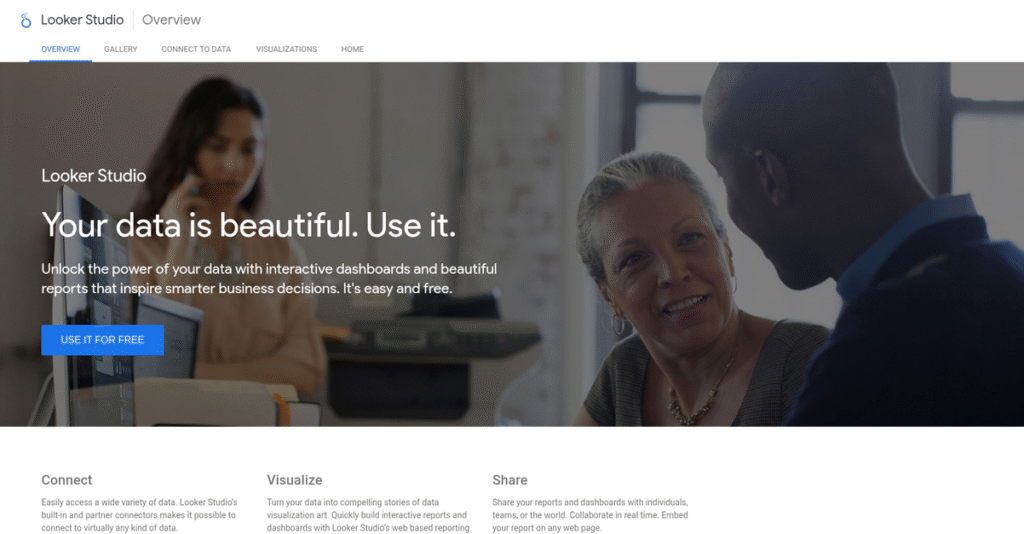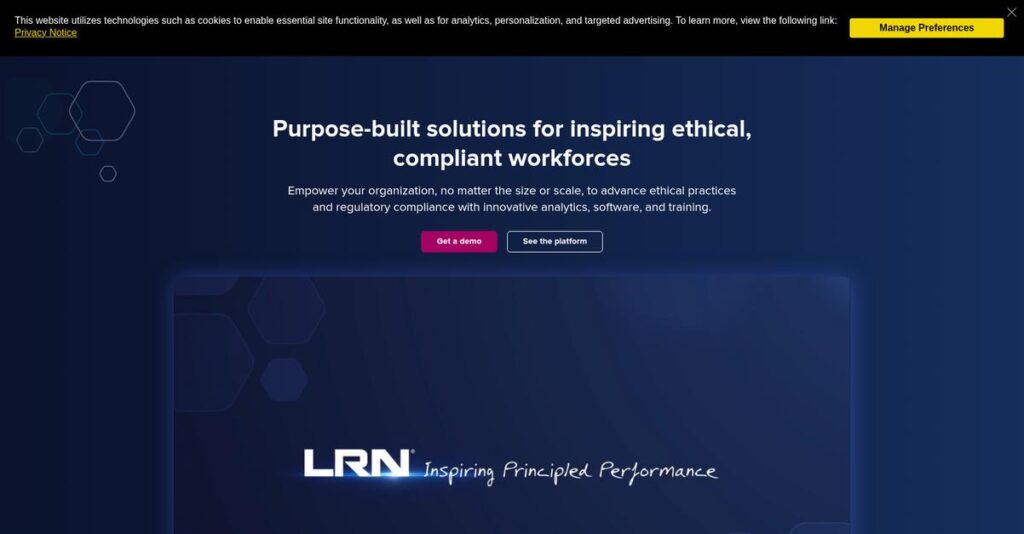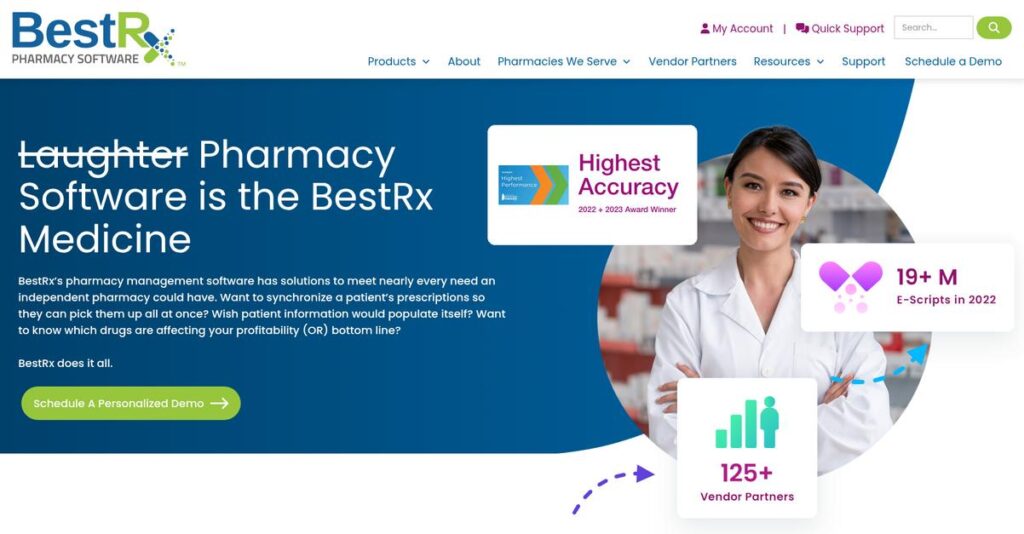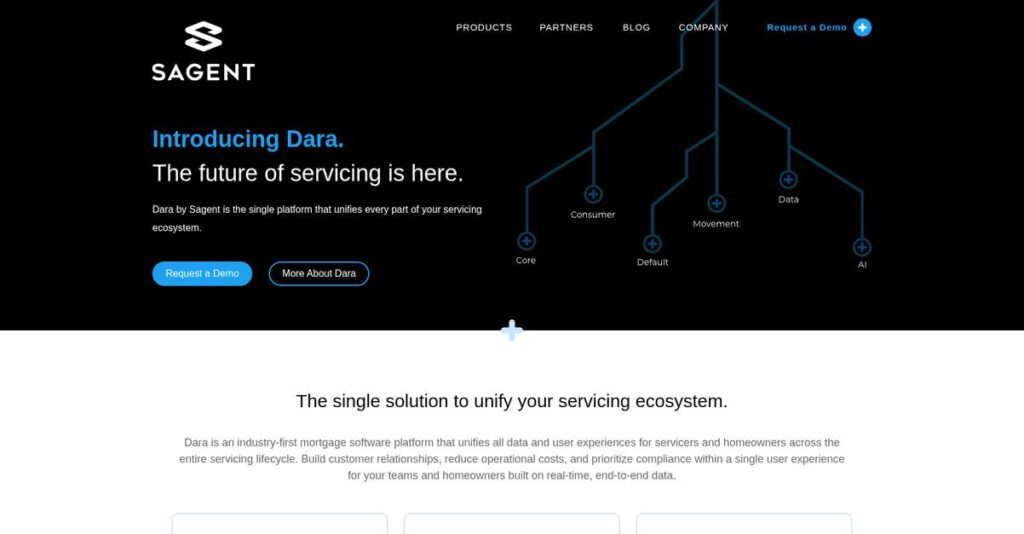Data chaos slowing down your reporting process?
If you’re dealing with messy data scattered across spreadsheets, analytics tools, and CRMs, finding a single source of truth feels impossible. That’s probably why you’re researching Looker Studio right now.
After analyzing Looker Studio in depth, I found that siloed data wastes hours on manual consolidation, leaving you scrambling before every stakeholder meeting.
Looker Studio directly attacks this problem with 800+ data connectors, powerful data blending, and truly interactive dashboards—all built to save you time and headaches compared to cobbling reports together by hand.
In this review, I’ll break down how Looker Studio helps you create unified dashboards from raw data, no matter what platforms you’re using.
You’ll discover in this Looker Studio review how its core features stack up, what the pricing really means for your workflow, and where alternatives like Power BI or Tableau might fit in if your needs change.
Read on for the features you need to make confident software decisions—plus my honest analysis of what actually works in practice.
Let’s get started.
Quick Summary
- Looker Studio is a user-friendly BI tool that transforms data from multiple sources into interactive, shareable dashboards.
- Best for small-to-medium businesses and marketing teams invested in Google’s data ecosystem.
- You’ll appreciate its ease of use and seamless integration with Google Analytics, Ads, and Sheets for quick reporting.
- Looker Studio offers a powerful free version plus a paid Pro tier with enhanced team management and support options.
Looker Studio Overview
Looker Studio is Google’s powerful data platform, formerly known as Google Data Studio. Launched in 2016 from Mountain View, its core mission is making business intelligence truly accessible.
My research shows its sharp focus on marketers and analysts, especially those inside the Google ecosystem. It avoids enterprise complexity, giving you practical, intuitive, and fast dashboarding tools instead of a suite of overwhelming features.
The 2022 rebrand was a pivotal move following the Looker acquisition. For my Looker Studio review, the new Pro tier signals a clear commitment to supporting professional, collaborative teams.
Unlike competitors that can feel intimidating and expensive, Looker Studio is refreshingly approachable. Its main value is the entirely free and web-based starting point, which removes nearly all budget and IT friction for you.
I was surprised by just how broad its user base is. You’ll find it used by everyone from freelance consultants to dedicated analytics departments inside massive global corporations.
- 🎯 Bonus Resource: While we’re discussing data and system efficiency, my article on lab inventory management software covers tools for specialized resource management.
My analysis shows their strategy centers on democratizing BI through deep, native Google connectors. This directly addresses your team’s need for powerful, self-service insights without the traditional cost or complexity of enterprise tools.
Now let’s dive into its capabilities.
Looker Studio Features
Drowning in disparate data sources?
Looker Studio features help you unify scattered business data into clear, interactive reports. This Google product turns raw numbers into actionable insights. Here are the five main Looker Studio features.
1. Data Connectivity & Blending
Data scattered everywhere?
Manually combining data from various sources is a huge time sink. This leads to errors and outdated reports.
Looker Studio offers over 800 connectors, including many free Google ones. Its Data Blending feature lets you combine multiple sources, providing a unified cross-channel performance view. This feature simplifies complex data consolidation.
You can create one dashboard showing all key metrics. This means you easily gain a holistic understanding of your business efforts.
2. Interactive Dashboard & Visualization Builder
Static reports hindering insights?
Static reports lack interactivity and are difficult to explore. Your stakeholders can’t self-serve answers from the data.
Looker Studio provides a drag-and-drop canvas for charts, tables, and maps. Interactive controls allow dynamic filtering, enabling powerful self-service data exploration. This feature makes customizing visuals incredibly simple.
You build one master report with filters. Your stakeholders then personalize their views, saving significant time.
3. Calculated Fields & Data Transformation
Raw data not report-ready?
Your source data isn’t always perfect for reporting. You often need to create new metrics or clean up existing data.
You create ‘calculated fields’ directly, like spreadsheet formulas. Use functions for operations or text manipulation, such as grouping campaigns. This feature provides flexible in-report data transformation without altering source data.
You can create custom KPIs like ‘Lead-to-Customer Rate’ directly. This eliminates pre-processing data in external tools.
- 🎯 Bonus Resource: While we’re discussing data transformation for custom metrics, understanding how Applied Behavior Analysis Software can streamline care and reports is also valuable.
4. Sharing, Collaboration, and Embedding
Sharing reports a nightmare?
Distributing reports securely and ensuring everyone sees the latest version can be a hassle, leading to outdated insights.
Sharing operates like Google Docs: links, invites, or scheduled PDF deliveries. Its embedding feature places live, interactive reports directly. This provides seamless report distribution and accessibility.
Embed live dashboards on your intranet or portals. This ensures everyone has access to real-time metrics, eliminating extra logins.
5. Looker Studio Pro Features (For Teams)
Need better team collaboration?
The free version lacks robust governance. As usage grows, managing report ownership and access becomes difficult.
The paid ‘Pro’ version introduces team workspaces for asset management. This enables proper asset ownership and team-level access. It also includes Google Cloud Customer Care support. This brings enhanced governance and team collaboration.
You can create shared workspaces for clients. If an analyst leaves, reports remain accessible, ensuring team continuity.
Pros & Cons
- ✅ Intuitive drag-and-drop interface ensures a user-friendly experience for all.
- ✅ Seamless native integration with Google services for fast, reliable data import.
- ✅ Powerful, feature-rich free tier makes advanced BI accessible and affordable.
- ⚠️ Can suffer performance issues with large datasets or complex, blended reports.
- ⚠️ Many essential non-Google data connectors require separate, often expensive subscriptions.
What I love about these Looker Studio features is how they work together to create a complete, integrated reporting system. You can pull data, visualize it powerfully, and share it seamlessly.
Looker Studio Pricing
Clear pricing, clear value.
Looker Studio pricing offers a remarkably transparent dual-tier approach, blending a robust free solution with a specialized paid option. This breakdown helps set expectations for your data visualization budget.
| Plan | Price & Features |
|---|---|
| Looker Studio (Free) | $0 • Unlimited reports, users, editing • Free Google data connectors • All visualization tools • Community support |
| Looker Studio Pro | $7 per user, per project, per month • All Free features • Team Workspaces • Cloud Project linking • Enterprise support |
1. Value Assessment
Value for your budget.
From my cost analysis, what impressed me is how the free tier offers immense value for individual users and small teams, democratizing business intelligence without any cost. The $0 barrier removes financial risk entirely for exploring data visualization tools. This transparent Looker Studio pricing allows you to scale up only when enterprise-level features like team governance become critical.
This means your budget gets maximized initially, paying only for advanced collaboration and support when your team truly requires it for a cohesive approach.
- 🎯 Bonus Resource: Speaking of team support, if your business handles a lot of customer interactions, my article on best automatic call distribution software can be invaluable.
2. Trial/Demo Options
Try before you commit.
Google offers a free trial for Looker Studio Pro, often via Google Cloud credits, allowing you to thoroughly test its advanced features. What I found valuable is how this trial helps you validate team workspaces and enterprise support before making any financial commitment. This ensures you can evaluate the benefits of the Looker Studio Pro pricing in a real-world scenario.
This lets you experience the full functionality firsthand, minimizing any financial risk before investing in the advanced features.
3. Plan Comparison
Choosing the right plan.
The free Looker Studio serves individuals and small businesses perfectly, offering robust reporting capabilities without charge. However, what stands out is how Looker Studio Pro elevates team collaboration and asset governance, which is crucial for larger organizations. The $7 per user, per project pricing for Pro makes it a cost-effective solution for ensuring data continuity and team management.
This tiered structure helps you match Looker Studio pricing to your specific team size and governance requirements as your business scales.
My Take: Looker Studio’s pricing is highly accessible, with a generous free tier and a cost-effective Pro version. It’s ideal for anyone needing robust data visualization, particularly those already leveraging Google’s ecosystem.
The overall Looker Studio pricing reflects excellent value for robust data visualization. It empowers you to start free and scale predictably. For your business, this means a powerful BI tool without high entry barriers, ensuring transparent, scalable access.
Looker Studio Reviews
What do real Looker Studio users say?
My analysis of Looker Studio reviews dives into real user feedback from major platforms, offering insights into what actual customers experience with the software.
- 🎯 Bonus Resource: Speaking of performance, you might find my guide on best anti spyware software helpful for safeguarding your data.
1. Overall User Satisfaction
Users are largely satisfied.
From my review analysis, Looker Studio consistently garners high overall satisfaction, typically averaging 4.5/5 stars on major review sites. What I found in user feedback is how its value as a free product frequently impresses, making it highly accessible. This consistent positivity spans across various user demographics, highlighting broad appeal.
This satisfaction indicates you can expect a powerful, user-friendly tool, especially given its free value and seamless Google ecosystem integration.
2. Common Praise Points
Ease of use consistently shines.
Users consistently highlight the intuitive, user-friendly interface, especially for those familiar with Google tools. Review-wise, the drag-and-drop design simplifies dashboard creation, making complex visualizations accessible. Its seamless Google integration with Analytics, Ads, and Sheets is also a frequently cited benefit.
This means your team can quickly adopt and create reports, leveraging existing Google data without a steep learning curve.
3. Frequent Complaints
Performance and hidden costs vex users.
What stands out in customer feedback are reports of performance issues, particularly with large data sets or complex blends. Additionally, you’ll find that connecting to non-Google sources often requires costly third-party connectors, a hidden expense that users frequently lament in reviews.
These complaints suggest you might face speed limitations or unexpected costs for diverse data, but are not universal deal-breakers.
What Customers Say
- Positive: “The best part about Looker Studio is its simple connectivity with all the Google Marketing Platform tools. I can easily pull data from Google Ads, GA4, and Search Console to create a centralized dashboard for my marketing efforts.”
- Constructive: “My biggest frustration is the slowness. When you blend multiple data sources or have a dashboard with 20+ charts, it can take 30-60 seconds to load, which is painful when presenting to a client.”
- Bottom Line: “It’s free and it’s from Google, which is a killer combination. For 90% of our marketing reporting needs, it’s more than enough. The learning curve was very gentle for our team.”
Overall, Looker Studio reviews reflect a highly valuable free tool with clear strengths and manageable limitations. User feedback is remarkably consistent.
Best Looker Studio Alternatives
Too many BI tools to choose from?
Navigating the best Looker Studio alternatives requires understanding your specific business needs. From my competitive analysis, I found several strong options, each excelling in different business scenarios.
1. Microsoft Power BI
Already deep in the Microsoft ecosystem?
Microsoft Power BI makes more sense if your organization heavily uses Office 365, Excel, and Azure. This alternative offers a more powerful data modeling engine (DAX) and a robust desktop application for complex transformations. You’ll gain deeper analytical capabilities for extensive data analysis scenarios.
Choose Power BI when your priority is intricate data modeling within a Microsoft-centric environment, accepting a steeper learning curve than Looker Studio offers.
- 🎯 Bonus Resource: While we’re discussing complex data environments, understanding user research software is equally important for gaining clear insights.
2. Tableau
Prioritizing stunning, pixel-perfect visualizations?
Tableau is the gold standard for visual quality and design flexibility. What I found comparing options is that this alternative provides unparalleled control over dashboard aesthetics, ideal for executive reporting or public-facing data stories. It offers deep customization for impactful presentations.
You should choose Tableau if visual storytelling is paramount and your budget accommodates its higher licensing costs compared to Looker Studio.
3. Metabase
Seeking self-service for non-technical users?
Metabase excels at empowering business users to ask simple data questions without needing an analyst, especially with its “Ask a question” feature. This open-source alternative provides simpler query capabilities for widespread adoption, though its dashboard design is less flexible than Looker Studio’s.
Consider Metabase if you need a self-hosted solution for data privacy or your goal is empowering business users with basic self-service BI.
Quick Decision Guide
- Choose Looker Studio: Free, easy-to-use, Google ecosystem integration, marketing analytics.
- Choose Microsoft Power BI: Deep Microsoft integration, complex data modeling, advanced analytics.
- Choose Tableau: Premium visual design, sophisticated dashboards, high-impact data storytelling.
- Choose Metabase: Empower non-technical users with self-service queries, open-source flexibility.
The best Looker Studio alternatives are not one-size-fits-all. Your ideal choice depends on your specific business needs and existing tech stack for optimal integration. Explore what fits your unique situation.
Setup & Implementation
Ready for a straightforward BI rollout?
Looker Studio deployment is generally accessible, but its true implementation complexity varies significantly with your data needs. This Looker Studio review will help set realistic expectations.
- 🎯 Bonus Resource: While discussing complex data needs, understanding specialized tools like legal research software can be insightful.
1. Setup Complexity & Timeline
Surprisingly simple to get started.
Looker Studio offers instant setup as a browser-based tool, only requiring a Google account. Connecting to Google data sources is wizard-driven and takes minutes. However, What I found about deployment is that third-party database connections add complexity, requiring careful authentication and credential management, extending initial implementation time.
For your implementation to succeed, plan to map out all your data sources upfront, prioritizing native Google connections for speed.
2. Technical Requirements & Integration
Minimal technical overhead required.
As a fully browser-based platform, Looker Studio avoids software installation or server provisioning, significantly reducing your IT burden. Implementation-wise, you simply need a Google account. Yet, what I found about deployment is that integrating non-Google sources introduces hidden costs and technical hurdles, often requiring separate third-party connectors.
Your IT team should assess existing data source types and budget for potential third-party connector subscriptions or API integrations beyond the free tool.
3. Training & Change Management
Gentle learning curve, but depth varies.
The intuitive interface makes basic dashboard creation accessible in an afternoon, especially for users familiar with Google products. From my implementation analysis, mastering advanced features demands dedicated practice in areas like data blending and complex calculations, which requires more structured training for your team.
You’ll want to prepare for ongoing learning paths for power users and establish clear data governance practices to ensure consistent reporting.
4. Support & Success Factors
Support scales with your investment.
For free users, Google’s extensive documentation and community forums provide a solid, albeit unofficial, knowledge base. What I found about deployment is that Looker Studio Pro offers critical direct support, essential for businesses requiring guaranteed response times and official assistance during complex implementation challenges or performance issues.
For your implementation to succeed, evaluate if your business needs the SLA-backed support of the Pro version to mitigate risks and ensure reliable operation.
Implementation Checklist
- Timeline: Instant setup, days to weeks for full data integration
- Team Size: Data analysts, marketing pros; IT for complex integrations
- Budget: Minimal software cost; budget for third-party data connectors
- Technical: Google account; authentication for non-Google data sources
- Success Factor: Clear data strategy and performance optimization
Overall, Looker Studio implementation is remarkably accessible for quick reporting, especially within the Google ecosystem. Achieving advanced insights and optimizing performance requires dedicated effort and strategic planning for success.
Who’s Looker Studio For
Who benefits most from Looker Studio?
This Looker Studio review explores who truly thrives with this powerful tool. I’ve analyzed user feedback and capabilities to help you quickly determine if it aligns with your specific business profile, team size, and use case needs.
1. Ideal User Profile
Perfect for data-driven teams focused on Google data.
Looker Studio is ideal for digital marketers, SMB owners, and data analysts in small teams. From my user analysis, teams heavily invested in the Google ecosystem will find immediate value, easily connecting GA4, Google Ads, and Sheets. This tool serves those prioritizing quick, visual insights.
You’ll achieve success if your main goal is to visualize readily available data for reporting without complex modeling requirements.
2. Business Size & Scale
Best for small to medium-sized businesses.
Looker Studio excels within small to medium-sized businesses (SMBs) where budget is a significant factor. What I found about target users is that it’s an excellent, free starting point for creating initial KPI dashboards without a large BI investment. It’s less suited for large enterprise-wide BI deployments.
Your business is a good fit if you need cost-effective visualization and your team can manage data sources.
- 🎯 Bonus Resource: While we’re discussing business profiles, understanding how to protect your reputation is crucial. My analysis of best brand monitoring tools can guide you.
3. Use Case Scenarios
Visualize and share marketing and operational data.
Looker Studio shines when your primary need is data visualization and reporting, especially if your critical data resides within the Google ecosystem. From my analysis, it excels at consolidating campaign performance from Google Ads and GA4, creating unified dashboards. Embedding live charts into websites is also a strong point.
You’ll find this tool valuable for quick reporting, client dashboards, or tracking essential business metrics without deep analytical requirements.
4. Who Should Look Elsewhere
Not ideal for complex data science or Microsoft shops.
If your company is standardized on the Microsoft stack or requires deep, complex data modeling, Looker Studio isn’t your best fit. From my user analysis, users needing robust ETL and advanced analytics will find its limitations. Performance can also be an issue with very large datasets.
Consider Power BI for Microsoft integration and advanced modeling, or Tableau for enterprise-level BI and intricate data analysis.
Best Fit Assessment
- Perfect For: Digital marketers, SMBs, small data teams using Google ecosystem
- Business Size: Small to medium-sized businesses prioritizing cost-effectiveness
- Primary Use Case: Data visualization, Google data consolidation, simple reporting
- Budget Range: Cost-conscious, leveraging free core features; aware of connector costs
- Skip If: Heavy Microsoft stack, complex data modeling, real-time monitoring
This Looker Studio review confirms its strong fit for specific profiles. The question is, does it align with your data needs and existing tech stack? Your journey to better data visualization begins with this self-qualification.
Bottom Line
Looker Studio: Is it right for you?
This Looker Studio review synthesizes my comprehensive analysis to provide you with a clear, honest assessment and a final recommendation for your data visualization needs.
1. Overall Strengths
Looker Studio delivers exceptional value.
The platform succeeds by offering an intuitive, user-friendly interface that simplifies complex data visualization, especially for Google ecosystem users. From my comprehensive analysis, seamless Google integration streamlines reporting workflows across your marketing and analytics efforts. Its powerful free tier makes it highly accessible for businesses of all sizes seeking robust reporting without significant cost.
These strengths translate directly into faster dashboard creation and a reduced barrier to entry for effective data analysis.
2. Key Limitations
Certain limitations demand careful consideration.
While powerful, Looker Studio can suffer from performance issues with large datasets or complex data blends, impacting load times. Based on this review, third-party connector costs become significant hidden expenses for integrating non-Google data sources. Additionally, its data modeling capabilities are basic compared to dedicated enterprise BI tools, limiting advanced analysis.
These limitations are manageable for many but necessitate a realistic understanding of its scope before committing resources.
- 🎯 Bonus Resource: While we’re discussing understanding its scope, my analysis of accreditation management software can assist in organizational readiness.
3. Final Recommendation
Looker Studio earns a strong, conditional recommendation.
You should choose this software if you operate within the Google ecosystem, prioritize ease of use, and need cost-effective dashboards for basic-to-intermediate reporting. From my analysis, this solution excels for marketing and analytics teams seeking quick insights from their Google data. It’s less suited for enterprise-level data modeling or complex cross-platform BI requiring extensive custom connections.
My recommendation is confident for its target audience, provided you understand its specific capabilities and limitations.
Bottom Line
- Verdict: Recommended with reservations
- Best For: SMBs and marketing teams in the Google ecosystem
- Biggest Strength: Free tier, ease of use, and Google integration
- Main Concern: Performance issues and third-party connector costs
- Next Step: Try the free version to assess your data needs
This Looker Studio review offers high confidence for its targeted user base, providing powerful data visualization for the right applications.






